Tessa’s Recipe Rundown
Taste: Bright and fresh with the perfect amount of sweet lemon flavor.
Texture: Moist and tender, but not too delicate.
Ease: Very easy! The glaze is an extra step, and it’s not completely necessary, but it adds more flavor and moisture to the cake.
Pros: Beautiful and vibrant cake.
Cons: None!
Would I make this again? I’ve already made it several times now!
This post may contain affiliate links. Read our disclosure policy.
Sometimes there’s nothing I crave more than the bright, vibrant, and fresh taste and aroma of fresh lemon. Like a fresh slice of moist, buttery, Lemon Bundt Cake.
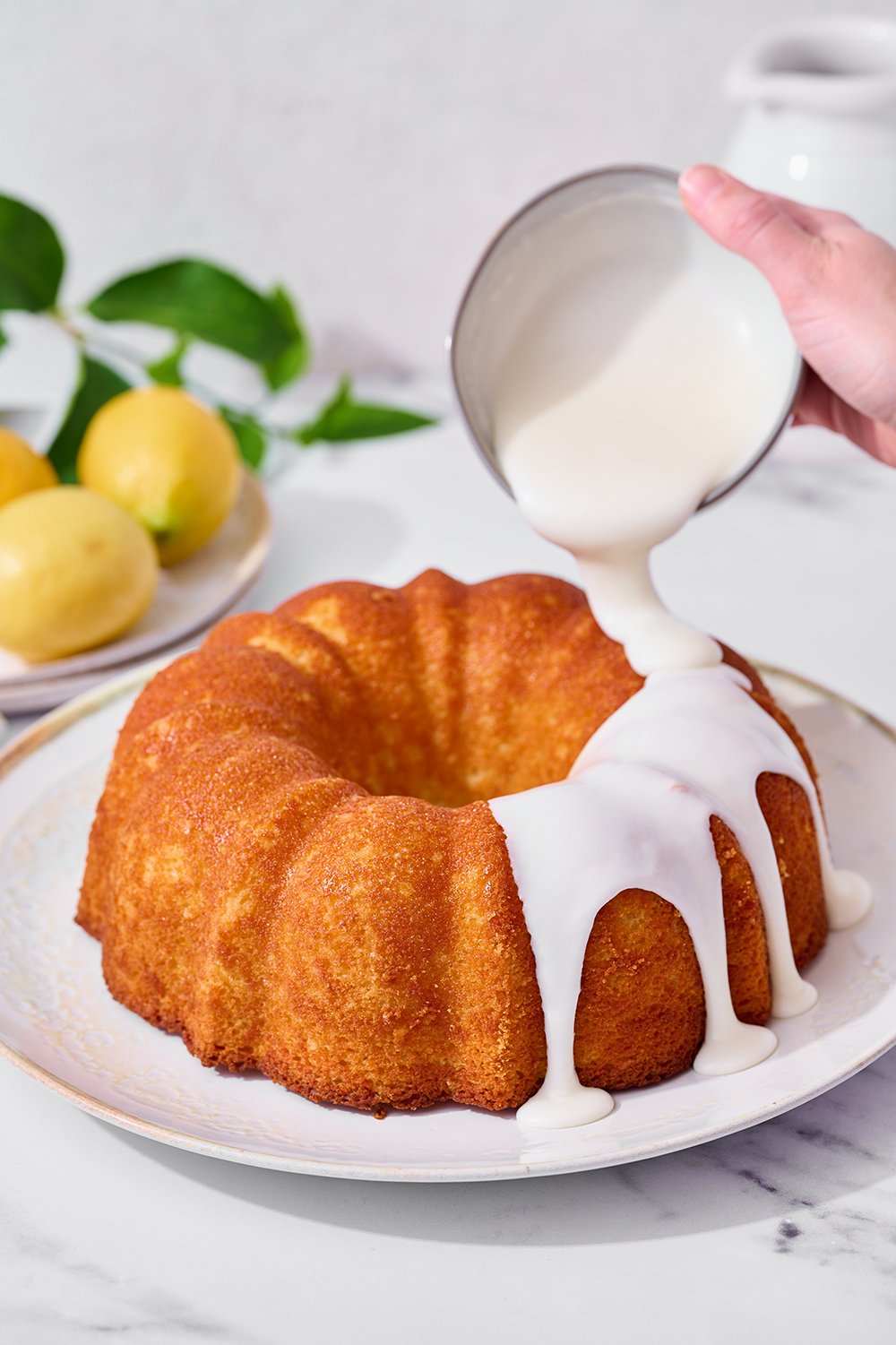
As a complete chocoholic, this tends to be a deviation from my usual sweet cravings.
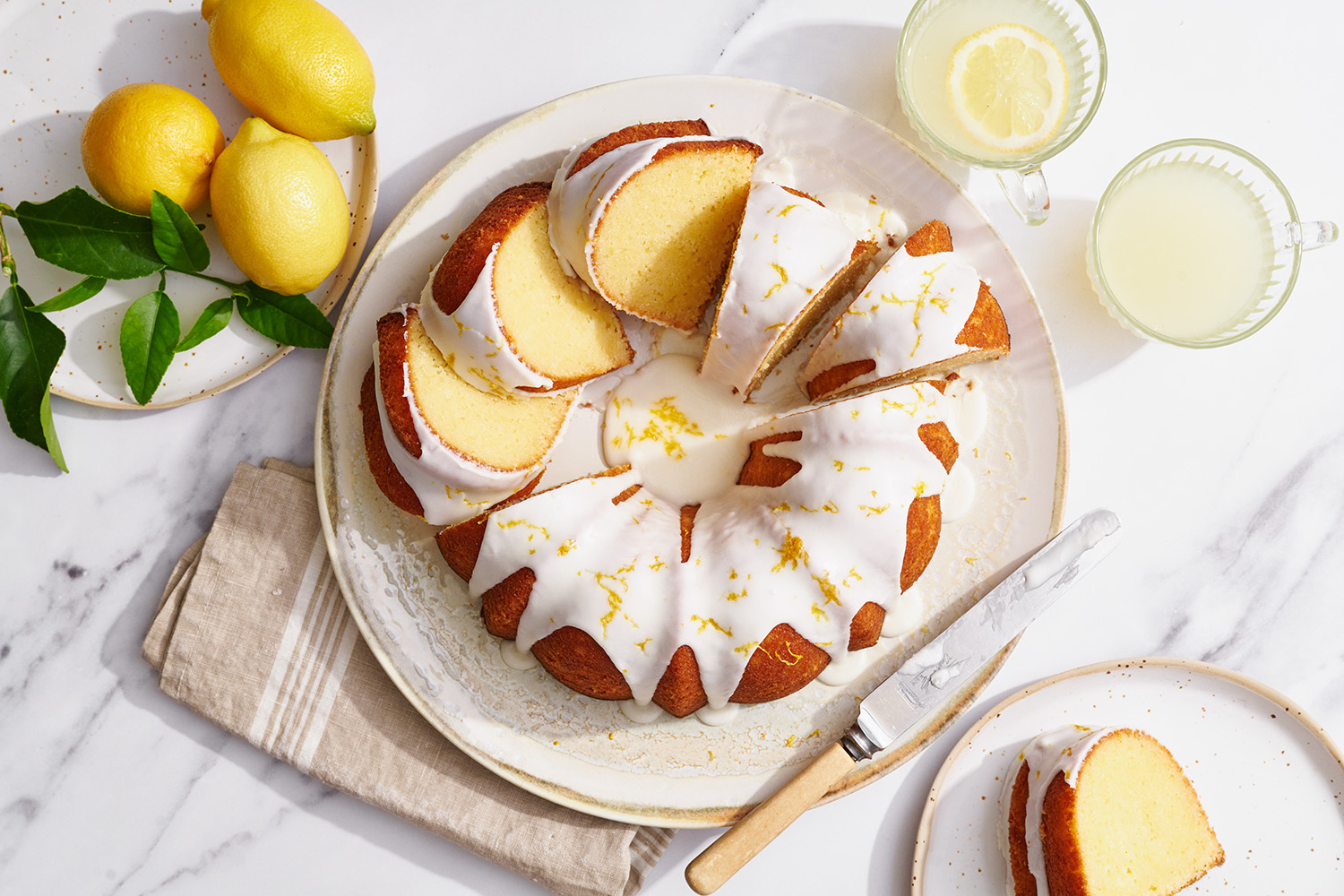
While this cake is delicious year-round, it’s the perfect citrusy dessert to enjoy during spring and summer. Also, this lemon cake smells absolutely amazing while it bakes. Imagine the combination of the smells of a clean house, a bakery window, and the best candle ever. Guests won’t want to leave when they smell this baking!
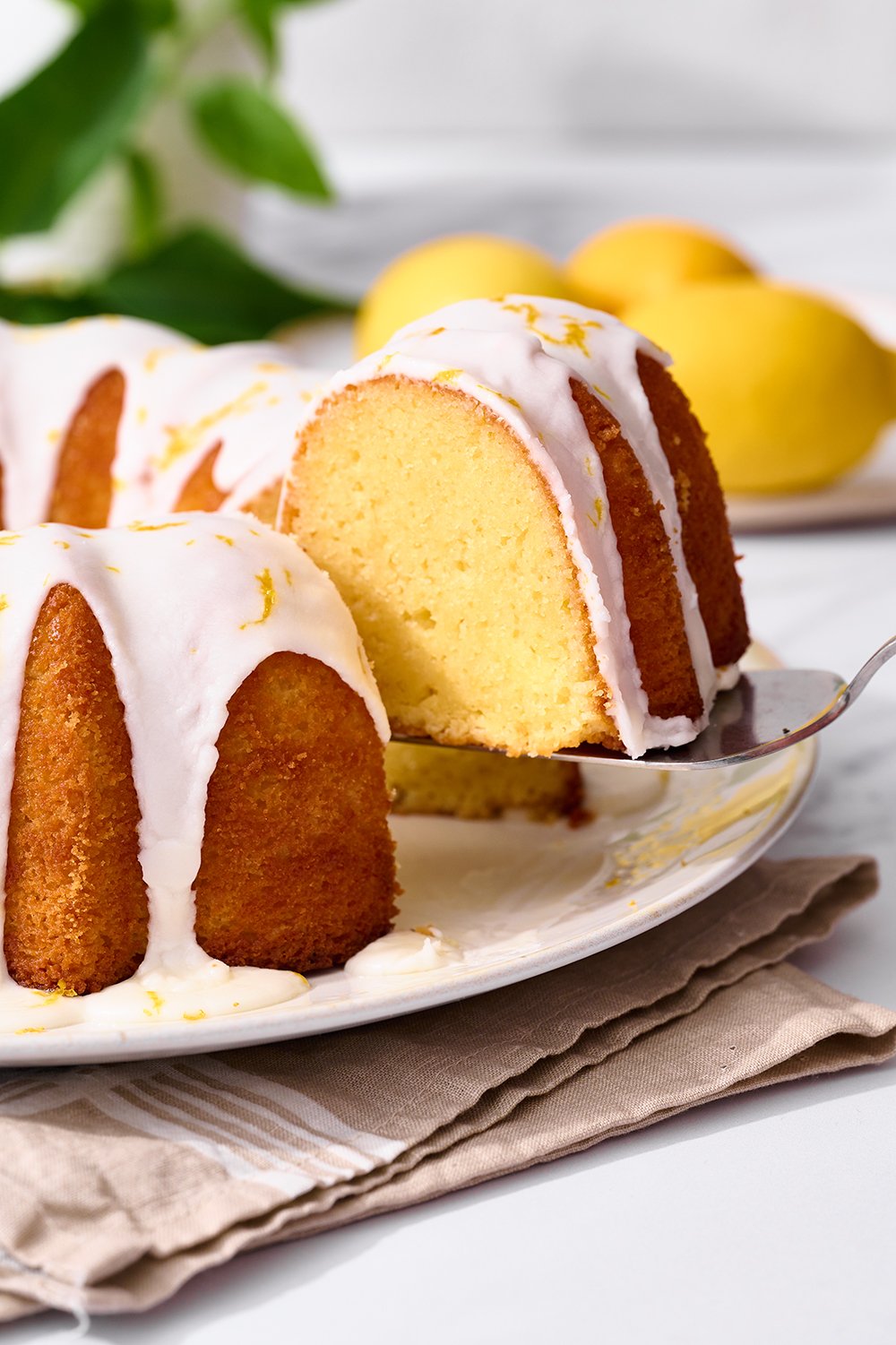
After the cake is done baking, it gets a drenching of lemon glaze. This amplifies the citrus flavor and boosts the moisture of the cake.
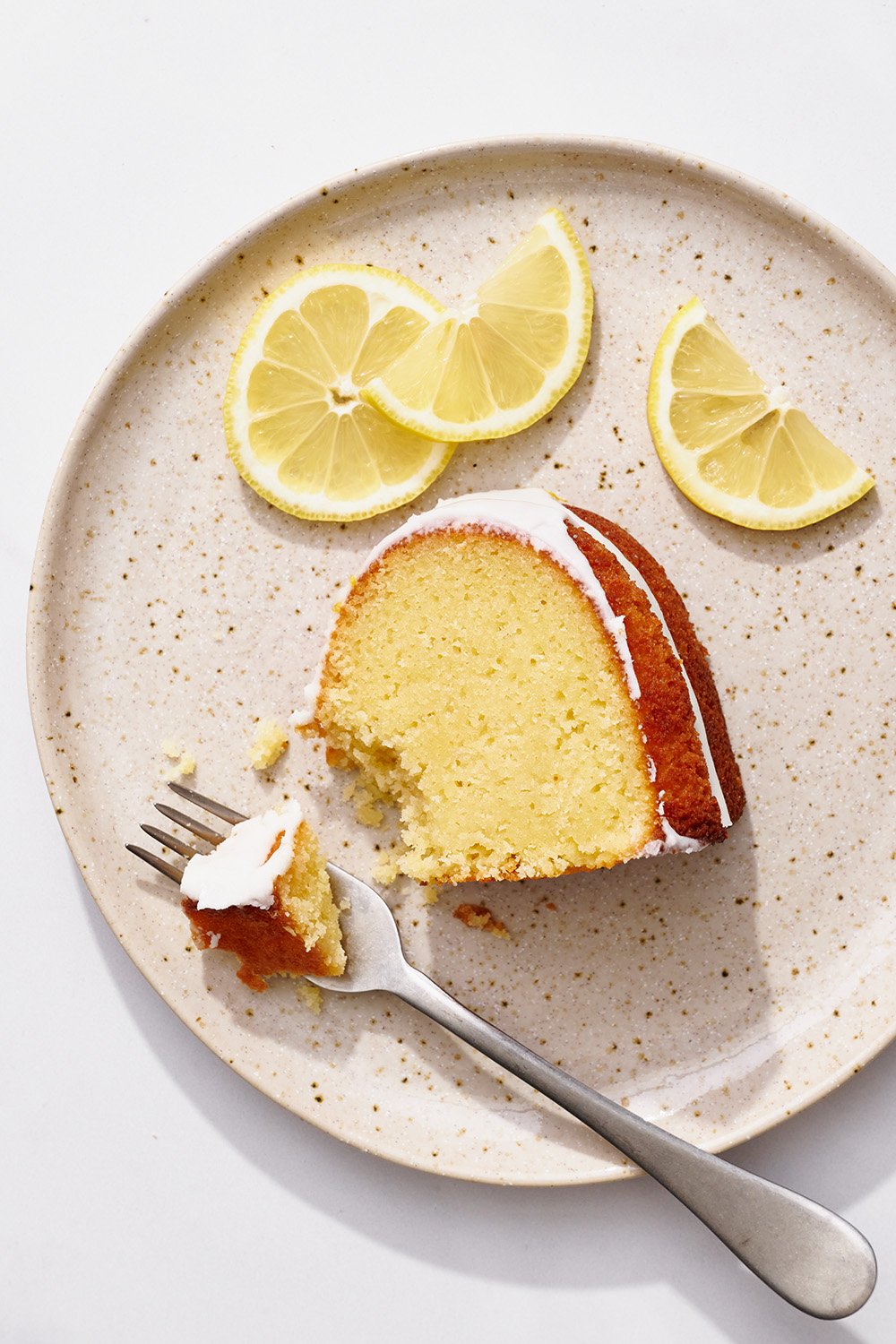
The icing on this best Lemon Bundt Cake recipe is just the way I like it: ultra thick and smooth! Feel free to add more or less cream or lemon juice to thicken or thin it out, but I think thick icing makes a bundt cake extra beautiful and gourmet. Just be sure to let the icing set completely before you serve or transport it.

Sprinkle of Science
How to Make Lemon Bundt Cake
What is the Difference Between Cake and Bundt Cake?
The main difference is the style of baking pan that’s used. A bundt pan is typically 10 to 12 cups in volume capacity, whereas a single 8-inch round cake pan has 6 cups volume capacity. Besides the shape and design, Bundt cakes are typically more dense, moist, and sturdy than some layer cakes. They need to hold up to the more intricate design of the Bundt cake pan without collapsing or breaking apart. Bundt cakes are also typically covered in an icing or glaze instead of being assembled with buttercream frosting.
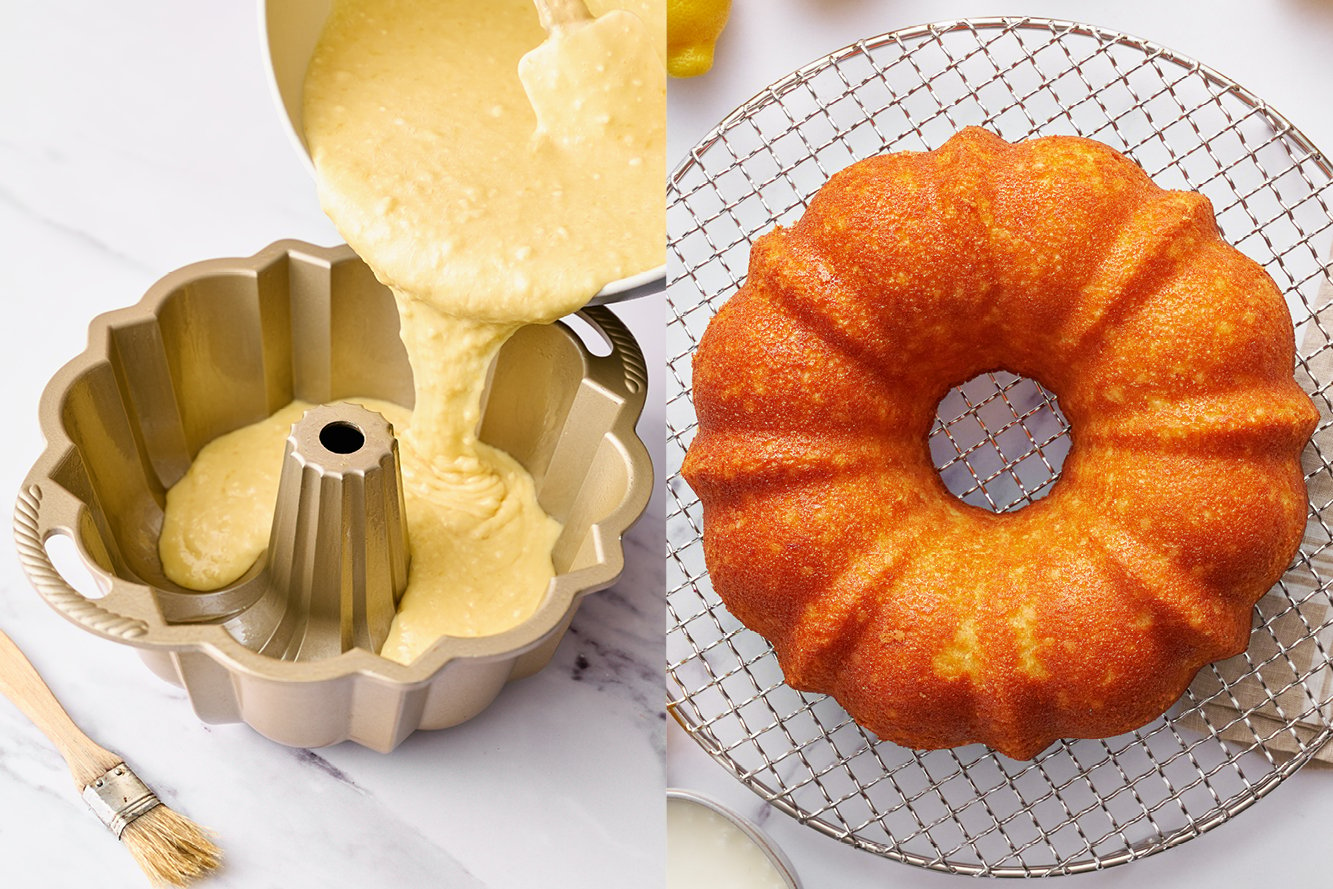
How to Make MOIST Cake
- Don’t overmeasure your flour. Accidentally adding too much flour will yield a dense, dry, or crumbly cake. I highly recommend using a digital kitchen scale, but if you don’t have one, use the spoon and level method to measure your dry ingredients.
- 8 large eggs – Eggs are crucial to this bundt cake’s richness, moisture, and structure. I do not recommend using egg substitutes in this recipe. Use room-temperature eggs to ensure they blend smoothly into the batter.
- Don’t reduce the sugar – Sugar does so much more in baking beyond simply sweetening. Learn more about sugar’s role in baking here.
Can I Use Baking Soda Instead of Baking Powder in Cake?
Baking powder and baking soda are both chemical leaveners that work to create light textures in baked goods. Although baking powder actually contains baking soda, the two leaveners are very different. Baking powder and baking soda are NOT interchangeable, so make sure to use baking powder for this recipe.
Check out my Baking Soda vs. Baking Powder article to learn how to test your leaveners for freshness (very important!) and for more information, as well as more shocking baking experiment results like this one below:
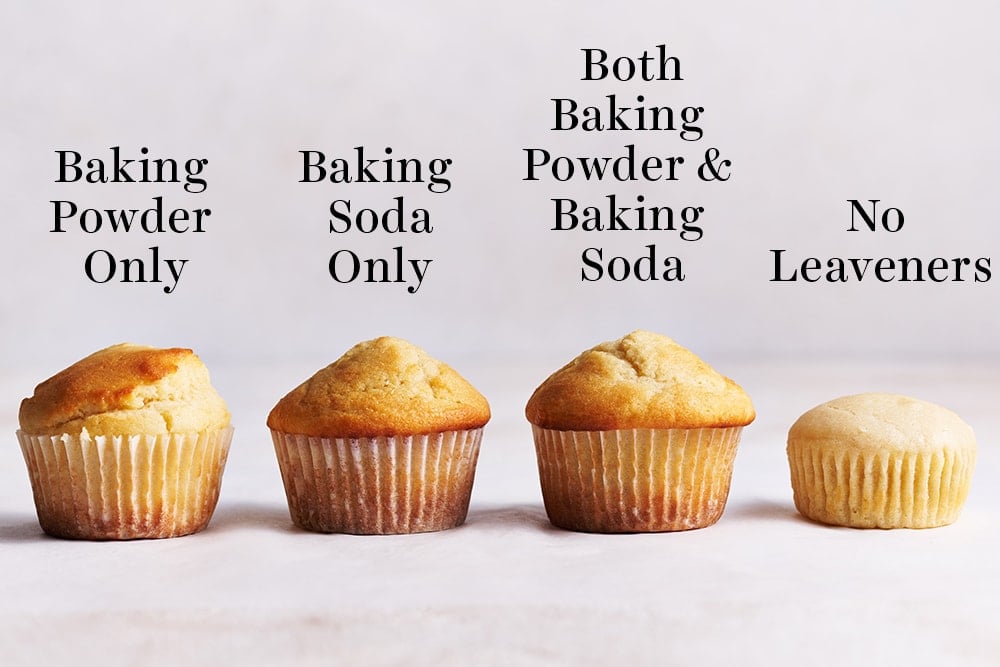
Do I Have to Use Cake Flour in this Lemon Bundt Cake?
- This recipe uses half all-purpose flour and half cake flour for the best of both worlds.
- When using only all-purpose flour, the cake has more of a muffin texture.
- When using only cake flour, the cake is too delicate and crumbly.
- While you can use only all-purpose flour in the flour mixture, I’d highly recommend using real cake flour for the best results.
- Check out my Cake Flour 101 article here (and why I don’t use DIY substitutes) for more on the science of this ingredient.
Do You Glaze a Cake When it’s Hot?
Allow the bundt cake to cool completely before glazing; otherwise, the glaze will melt right off the hot cake.
How to Prevent Bundt Cake from Sticking
There’s absolutely nothing worse than spending a bunch of time, energy, and ingredients on a cake only to have it stick to the pan and fall apart like the cake on the right:
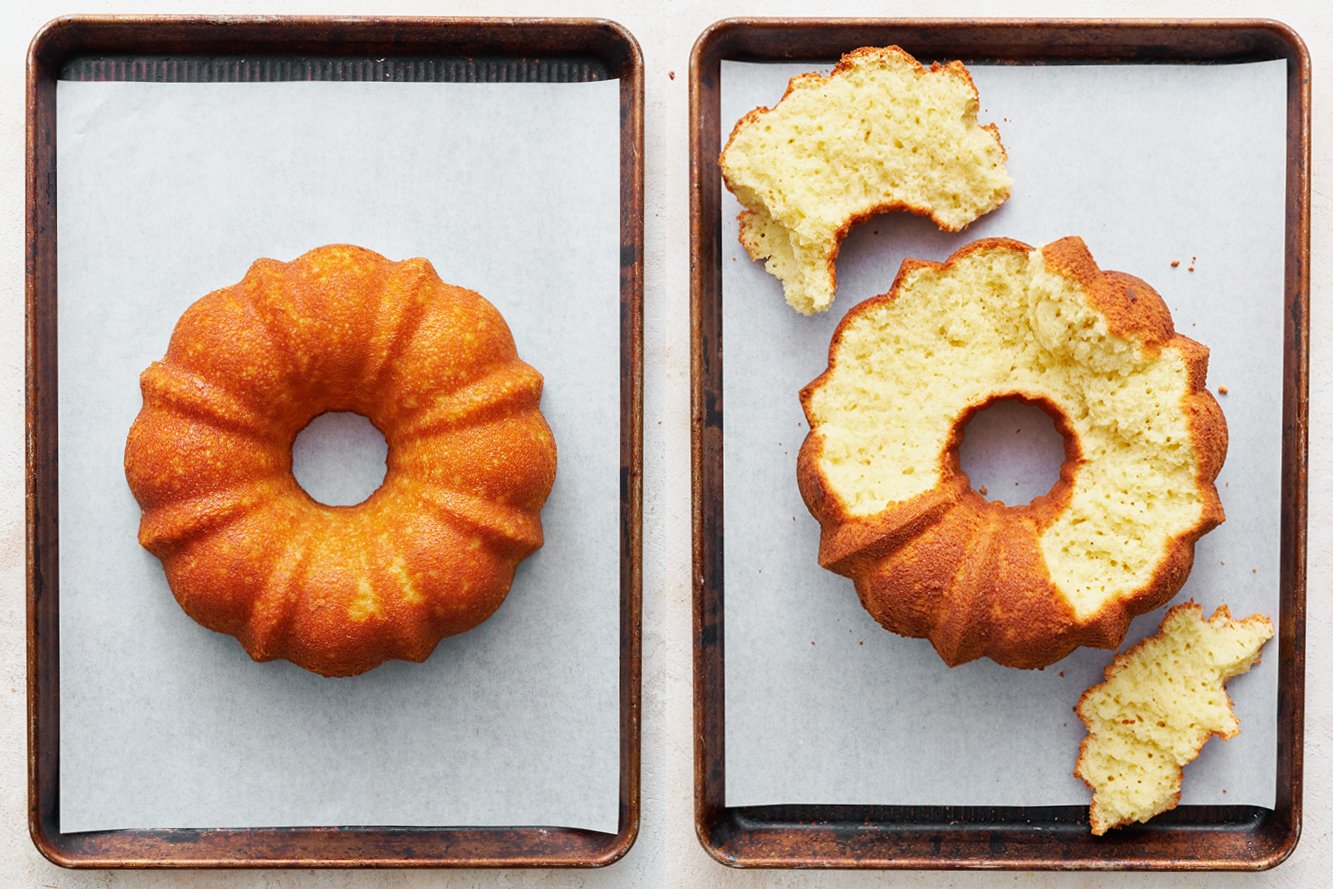
Here are my three top tips for preventing bundt cakes from sticking to the pan:
- Use a simple, quality nonstick bundt pan and take proper care of it (hand washing and drying instead of using the dishwasher). This is the best bundt pan I’ve found.
- Use the right type of grease. I use baker’s nonstick cooking spray for this recipe, specifically Baker’s Joy. I’ve also had success in the past using melted shortening to grease other bundt cake recipes.
- Grease every nook and cranny of the bundt pan just before baking. This prevents the grease from sliding down the sides of the pan and collecting in a pool at the bottom by the time you pour in the batter. Use a pastry brush to generously apply the grease, being careful to get every centimeter, including the middle column.
- In my How to Prevent Bundt Cakes From Sticking article, I detail even more of my best tips for bundt cake that glides out of the pan perfectly. I also share some tricks for releasing a cake that’s already stuck.
Should You Let a Bundt Cake Cool Before Flipping It?
After baking the cake, cool it in the pan for 15 to 20 minutes, then run a thin, flexible knife around the edges before inverting it onto a wire cooling rack.
Topping Ideas for Best Lemon Bundt Cake Recipe
- The Lemon Glaze included in the recipe below
- Fresh berries, such as strawberries or blueberries
- Whipped cream
- Cream cheese frosting (if using cream cheese frosting, serve the same day you frost – refrigerating this cake will dry it out)
- A dusting of powdered sugar
- Learn How to Make Ice cream with my simple, easy-to-follow recipe!
How to Store Lemon Bundt Cake
The glazed cake can be covered in foil or plastic wrap and stored at room temperature for up to 2 days. Don’t refrigerate this cake as that will just dry it out. Wrap sliced leftovers well in plastic wrap and store in a ziptop bag or an airtight container for up to 2 days.
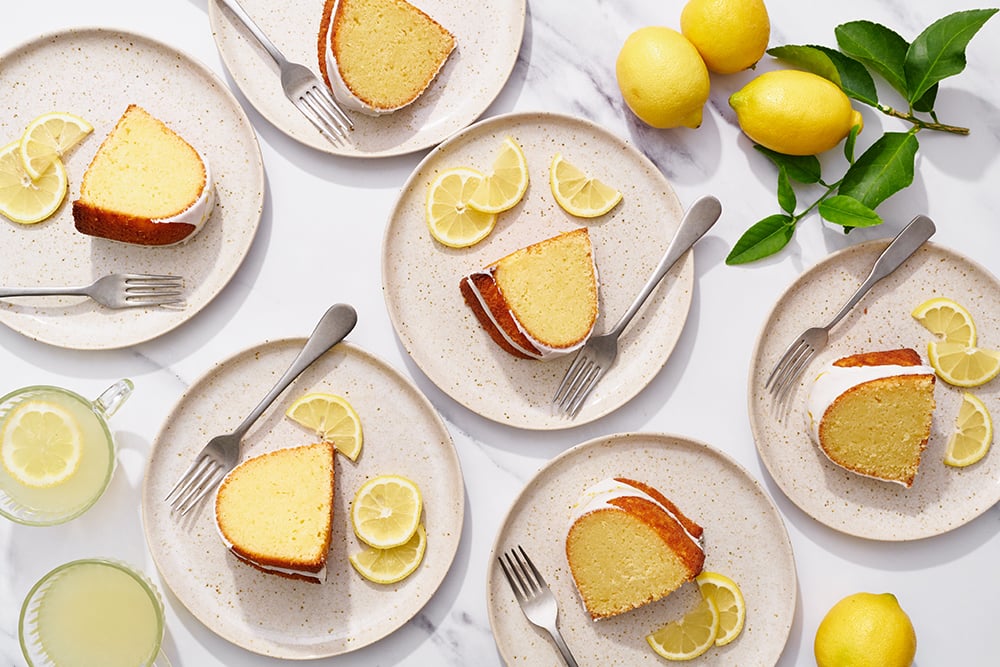
More Lemon Recipes You’ll Love:
- Lemon Pound Cake Loaf
- Lemon Cupcakes
- Lemon Cheesecake
- Lemon Poppy Seed Muffins
- Glazed Lemon Cookies
- Lemon Yogurt Zucchini Bread
More Cake Recipes You’ll Love:
- Chocolate Bundt Cake
- Strawberry Bundt Cake
- Peppermint Mocha Bundt Cake
- Angel Food Cake
- Flourless Chocolate Cake

Become a Baking Genius!
Sign up for our free email newsletter for NEW recipes & baking science secrets.
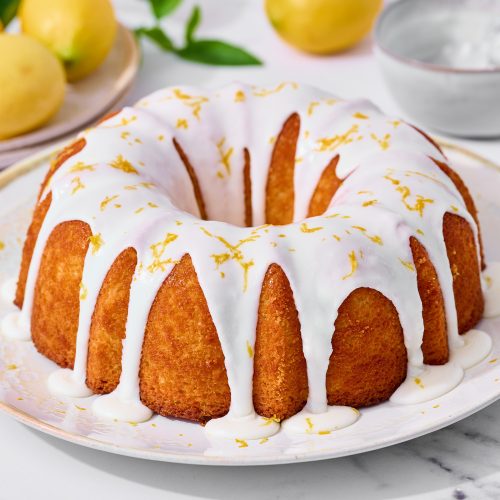
Lemon Bundt Cake
Ingredients
For the cake:
- 1 1/2 cups (191 grams) all-purpose flour
- 1 1/2 cups (170 grams) cake flour
- 2 teaspoons baking powder
- 1 teaspoon fine salt
- 2 1/2 cups (500 grams) granulated sugar
- 4 tablespoons fresh lemon zest (from about 6 lemons)
- 4 tablespoons fresh lemon juice (from about 2 lemons)
- 8 large eggs, at room temperature
- 1/2 cup (120 grams) sour cream*, at room temperature
- 4 sticks (452 grams) unsalted butter, melted and cooled
For the glaze:
- 2 1/2 cups (313 grams) powdered sugar
- 2 tablespoons fresh lemon juice
- 2 tablespoons milk or cream
Instructions
Make the cake:
- Preheat the oven to 350°F.
- In a large mixing bowl, sift together the all-purpose flour, cake flour, baking powder, and salt. Set aside.
- In the bowl of a food processor or high-speed blender, combine the sugar and lemon zest. Pulse a few times to evenly distribute the zest. Add the lemon juice, eggs, and sour cream and pulse until combined. On low speed, gradually drizzle in the melted and cooled butter in a slow steady stream until well combined.
- Make a well in the center of the dry ingredient mixture. Pour in the wet ingredients. Mix gently with a rubber spatula until just combined. Batter will be slightly thin.
- Grease a 10 or 12-cup bundt pan generously with baker’s nonstick cooking spray, such as Baker’s Joy, or melted shortening. Use a pastry brush to spread the spray into every nook and cranny of the pan. Immediately pour in the batter.
- Bake until a toothpick inserted into the center comes out clean or with just a few moist crumbs attached, about 50 to 60 minutes.
- Cool in pan for 15 to 20 minutes, then run a thin flexible knife around the edges before inverting onto a wire rack. Cool completely.
Make the glaze:
- In a small bowl, whisk together the glaze ingredients until thick but pourable. Add more juice or milk to thin out or more powdered sugar to thicken until your desired consistency. Spoon over the cake, letting it drip down the sides if desired. Let set for 15 minutes before slicing and serving.
- The glazed cake can be covered in foil or plastic wrap and stored at room temperature for up to 2 days.
Recipe Notes
This post was originally published in 2018 and has been updated with new photos and recipe improvements. Photos by Joanie Simon.

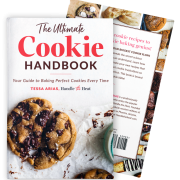


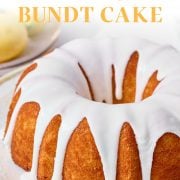

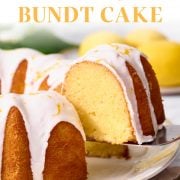

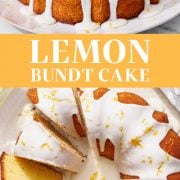
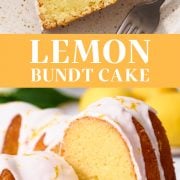
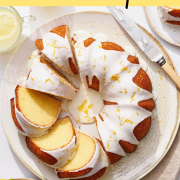

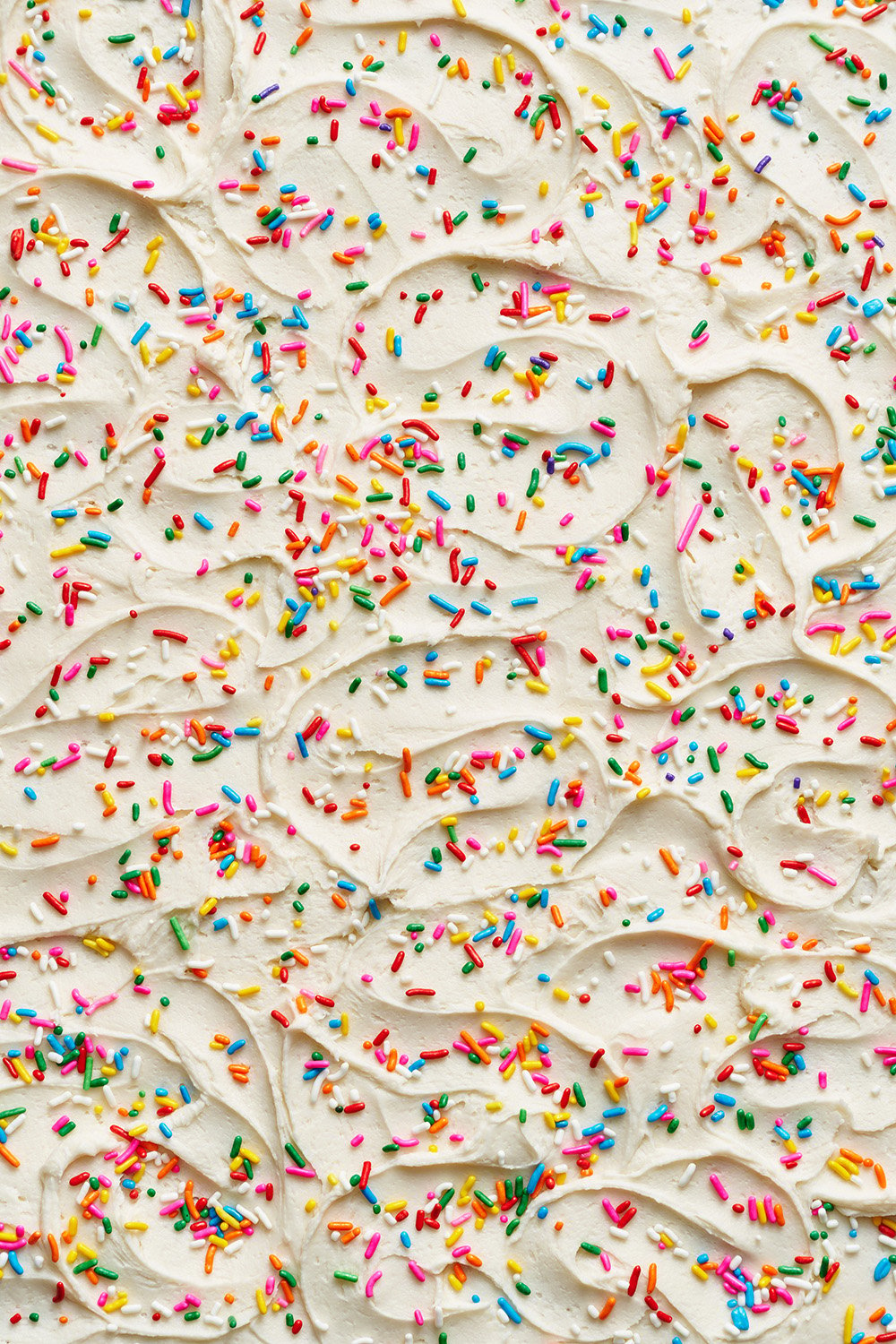
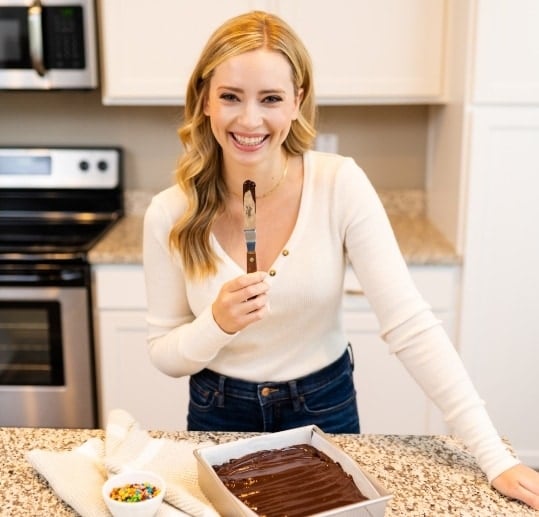

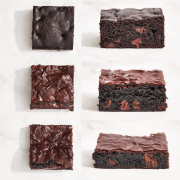
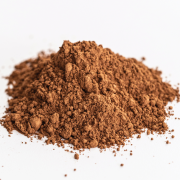
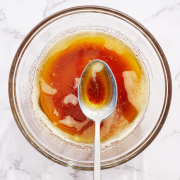
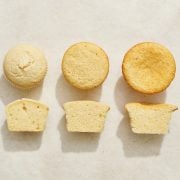

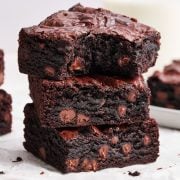

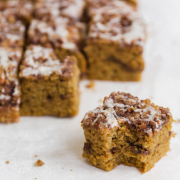








This recipe and the comments look amazing; I will definitely be trying it. I would love to make it for my family reunion, but without the nutritional values, I can’t chance it. Can they be posted for the recipe as written? Please and thanks.
Hi Willie! We don’t share nutritional information for our recipes; however there are numerous nutritional calculators online to assist with this if you wish. I truly hope this doesn’t deter you from making our delicious recipe, I bet it’ll be a huge hit at your reunion! Let us know how it goes if you give it a try 🙂
Everyone at the firehouse loved it. One question. What about adding blueberries?
Hi Jon! We haven’t tried that but it sounds like it would be delicious! Feel free to experiment with this and let us know how it goes! Happy baking!
Pint of blueberries worked great
Yay, so glad to hear that! Thanks so much for letting us know 🙂
What a fantastic, rich, buttery delight this cake was! I used Meyer lemons by mistake, but it was a mistake I’d gladly repeat. Everyone at the Easter dinner I was invited to loved this dessert. One eager young man diving into his second large piece of the cake announced to his mother, “Mamma, this is just like your pound cake, except good!” I pretended not to hear, but I did make sure I to let my hostess know where to come to find this and so many other excellent recipes. Thanks so much, genius Tessa, for this and so many other delicious recipes on your excellent website!
Your cake looks stunning, John! So happy to hear it was such a hit 🙂
Long time follower, and have made many of your recipes, but this recipe did not turn out well. The flavor was absolutely amazing, but the texture of the cake was very dense. I think it was the food processor. I will never use a food processor again in this manner.
Hi Gregory! I’m sorry to hear that this cake didn’t turn out as it should. Perhaps it was over-mixed in your food processor – feel free to experiment with other methods if you prefer. The density you found could be due to overmixing, or possibly adding too much flour – do you use a digital scale to weigh your ingredients? Learn more about that here. Also, was the recommended proportion of cake and all-purpose flour used? More on that in the tip box, above the recipe. It could also be that your baking powder is no longer active – learn more about that here. I hope something here helps, and I hope you’ll try this cake again – it really is fantastic! Happy baking 🙂
Phenomenal. I’m a seasoned baker and hard to impress. This cake is AMAZING. Followed recipe exactly and it was perfect I chose this blindly from reviews after a google search and I will be back. Thanks so much!
Can I use this recipe to make mini bundt cakes, if so, how many small cakes does this recipe make?
We haven’t tried that, so we can’t say for sure! Let us know how it goes if you give that a try 🙂
Hi, I was wondering if you did try this recipe as mini bundt cakes? I was hoping to use this recipe for that but would love to hear how it turned out for you if you did try it. Thanks!
Haven never made a bundt cake, my first one was a success. It came out exactly as pictured, and texture was perfect. Definitely had a buttery, lemon flavor with moist crumb and very similar to a pound cake. It was an excellent choice for his birthday – absolutely loved it. It will certainly be in our rotation.
Can I use this to make cupcakes?
Hi Angel! This bundt cake recipe is essentially a pound cake, so it’s fairly heavy, which doesn’t translate so well to cupcakes. You could certainly experiment and give it a try – but I can’t guarantee how good the result will be. Instead, you could try these Lemon Cupcakes, which have a delicious lemon cream cheese frosting! Happy baking! 🙂
I dont have a blender or food processor I used a hand mixer to blend the wet ingredients and tried to slowly pour the melted and cooled butter and this cake tasted amazing, but it was really dry and dense. After a day or so it kept tasting more and more like eggs.
Hi Wendy! I’m sorry to hear this bundt cake didn’t turn out as you had hoped. I definitely think something went wrong here, unfortunately! I would love to help you troubleshoot what may have happened here! Firstly, how do you measure your flour? By volume (using cups), or be weight (using a digital kitchen scale)? It’s so easy to add extra flour to a recipe and throw off the entire chemistry of a recipe if measuring by volume. Tessa talks about how to best measure ingredients, to ensure accuracy every time, in this article here! You also mentioned you don’t have a a food processor or blender, and instead used a hand mixer. This could have resulted in over-mixing, which would account for the density and dry texture. Lastly, I just want to mention your leavening agent. If your baking powder is not fresh, it won’t correctly lift and lighten your baked goods. Tessa talks about the science behind leavening agents, and how to test for leavener freshness, in this article here! I hope this helped! Please feel free to reach back out if you have any further questions! Happy baking 🙂
Hi Kiersten,
I do have a scale and I did buy a new tin of baking powder. I definitely think the problem is not having a food processor or blender. Should I mix everything by hand and not use a hand mixer at all? If so, how do I incorporate the butter?
Hi Wendy! Yes, in that case, I think you’re right – it would be best to just mix everything by hand, and just mix the butter in maybe 1/3 at a time, gently folding in between additions. You will need to be gentle and be careful not to overmix, but I think that’s the best way to ensure this cake has the best texture possible, without the tools recommended in the post. Good luck and happy baking!!
I made this for a group of 10 people. Everyone loved it!
Hi Carol! So happy you and your friends enjoyed this cake so much!!
Spectacular recipe! Made this beauty for my moms birthday and it did not disappoint. My bundt would not come out of that darn tin but I flipped it and used a hair dryer all around and after just a couple of minutes it slide right out!
Great lemon flavor and the perfect amount of sweetness. Can’t wait for another occasion to make this 🙂
Woohoo, so happy you were able to get the cake out of the pan, Maria!! So excited that you and your mom enjoyed this cake! 🙂